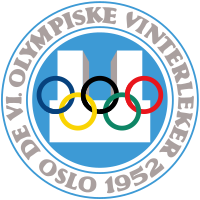
Back Осло 1952 Abkhazian Olimpiese Winterspele 1952 Afrikaans Chuegos Olimpicos d'hibierno de 1952 AN الألعاب الأولمبية الشتوية 1952 Arabic اوليمبياد شتا 1952 ARZ 1952 Qış Olimpiya Oyunları Azerbaijani Зімовыя Алімпійскія гульні 1952 Byelorussian Зімовыя Алімпійскія гульні 1952 году BE-X-OLD Зимни олимпийски игри 1952 Bulgarian Jocs Olímpics d'Hivern de 1952 Catalan
 Emblem of the 1952 Winter Olympics[a] | |
| Host city | Oslo, Norway |
|---|---|
| Nations | 30 |
| Athletes | 694 (585 men, 109 women) |
| Events | 22 in 4 sports (8 disciplines) |
| Opening | 14 February 1952 |
| Closing | 25 February 1952 |
| Opened by | |
| Cauldron | |
| Stadium | Bislett Stadium |
Winter Summer | |
The 1952 Winter Olympics, officially known as the VI Olympic Winter Games (Norwegian: De 6. olympiske vinterleker; Nynorsk: Dei 6. olympiske vinterleikane) and commonly known as Oslo 1952, was a winter multi-sport event held from 14 to 25 February 1952 in Oslo, the capital of Norway.
Discussions about Oslo hosting the Winter Olympic Games began as early as 1935; the city was keen to host the 1948 Winter Olympics, but that was made impossible by World War II. Instead, Oslo won the right to host the 1952 Games in a contest that included Cortina d'Ampezzo in Italy and Lake Placid in the United States. All of the Olympic venues were in Oslo's metropolitan area, except for the alpine skiing events, which were held at Norefjell, 113 km (70 mi) from the capital. A new hotel was built for the press and dignitaries, along with three dormitories to house athletes and coaches, creating the first modern athlete's village. Oslo bore the financial burden of hosting the Games in return for the revenue they generated. The 1952 Winter Olympics was the first of the two consecutive Olympics to be held in Northern Europe, preceding the 1952 Summer Olympics in Helsinki, Finland.
The 1952 Winter Games attracted 694 athletes representing 30 countries, who participated in four sports and 22 events.[1] Japan and Germany made their returns to Winter Olympic competition after being forced to miss the 1948 Games in the aftermath of World War II. Germany was represented solely by West German athletes after East Germany declined to compete as a unified team. Portugal and New Zealand made their Winter Olympic debuts, and women were allowed to compete in cross-country skiing for the first time.
Norwegian truck driver Hjalmar Andersen won three out of four speed skating events to become the most decorated athlete of the 1952 Winter Olympics. Germany resumed its former prominence in bobsleigh, with wins in the four- and two-man events. Dick Button of the United States performed the first triple jump in international competition to claim his second consecutive men's figure skating Olympic title. The popular Nordic sport bandy featured as a demonstration sport, but only three Nordic countries competed in the tournament. Norway dominated the overall medal count with 16 medals, including seven golds. The Games closed with the presentation of a flag that would be passed to the host city of the next Winter Olympics. The flag, which became known as the "Oslo flag", has been displayed in the host city during subsequent Winter Games.
Cite error: There are <ref group=lower-alpha> tags or {{efn}} templates on this page, but the references will not show without a {{reflist|group=lower-alpha}} template or {{notelist}} template (see the help page).
- ^ "Oslo 1952". International Olympic Committee. Archived from the original on 25 December 2018. Retrieved 27 April 2011.
© MMXXIII Rich X Search. We shall prevail. All rights reserved. Rich X Search